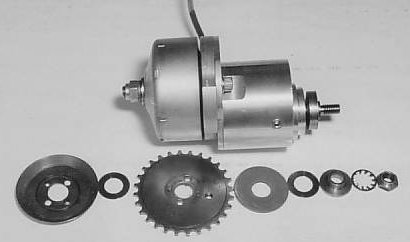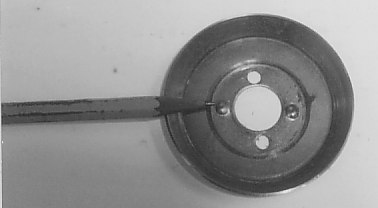
Vincent Technical
Sections: -Serial
Numbers/Production-
Photo Gallery of Models - Brakes
- Engine
Overhaul - Vincent
Engines - Wheels/Fenders
- Instruments - Transmission
- Clutch - Magneto
- Tank/Seat - Suspension
-
Tools - Norvin
-
Electrics-
Carburetors
- Misc - Links
-Vincent
Parts/Services Suppliers - Polishing/Cleaning
- Shipping Vincents-Electric
Starter - Paint/Transfers
The McDouglator Solves Vincent Motorcycle
Charging Problems
By Carl Hungness
 I
have discovered an alternator that in my estimation virtually solves any
problem we may have encountered with a reliable charging system for our
Vincent motorcycles. It will crank out 20 volts, 15 amps and 150
watts. The supplied regulator cuts back the volts to 13.8, perfect for
a 12 volt charging system. Best of all, the unit has been tried and
proven for the past 15 years on dozens of Vincent twins and a couple of
Comet singles. You do not need to modify or change anything on your bike
to install this alternator. Not only does it bolt right on but it has been
proven as reliable production unit on thousands of tractors world-wide.
I
have discovered an alternator that in my estimation virtually solves any
problem we may have encountered with a reliable charging system for our
Vincent motorcycles. It will crank out 20 volts, 15 amps and 150
watts. The supplied regulator cuts back the volts to 13.8, perfect for
a 12 volt charging system. Best of all, the unit has been tried and
proven for the past 15 years on dozens of Vincent twins and a couple of
Comet singles. You do not need to modify or change anything on your bike
to install this alternator. Not only does it bolt right on but it has been
proven as reliable production unit on thousands of tractors world-wide.
One John McDougall, a long-time VOC member who now resides in Vancouver,
British Columbia has re-developed a Kubota tractor alternator to give Vincent
riders all the power from a generating unit they would ever want.
The McDouglator as it is known, comes complete with a virtually indestructible
regulator. John has run the alternator unit in a drill press and literally
tried to ruin the regulator with no success in doing so. If you ever do
fry a Kubota regulator, you can buy a replacement in virtually any country
in the world. John discovered the Kubota unit back in the early 1990’s
when it was advertised as being a replacement for early Harley-Davidsons.
His pal George Hacking, who has racked up some miles on a Vincent himself,
brought the unit to John’s attention. The original manufacturer of the
conversion made a fateful decision in his version, as he believed the bearings
on the front of the alternator would keep oil from entering the unit itself.
However, oil from the timing chest on the Harley did seep into the rotor
area thereby negating its performance. Basically, the man who developed
it for the Harley took the Kubota unit, knocked the mounting ears off of
it, put in a couple of heli-coils and bolted it to the Harley. The oil
found its way past the sealed bearings and rendered the unit inoperable.
McDougall, a pipefitter by trade and accomplished machinist set about to
make a drive system that would dovetail with usage on the Vincent. In all,
he has made three separate drive units to accommodate the Series “B”, “C”
and Comets. The geometry of each is different thereby necessitating engineering
for all three separate bikes.
What he came up with is a small gearbox he machines from billet
that ultimately turns the Kubota at one and one half-engine speed. Our
original generators were driven at one and a quarter engine speed. John
cuts his own gear blanks and has a gear cutter finish them. The drive gear
has 18 teeth, the driven gear 15. The gears are literally the same as we
use in the timing chest of our Vincents, 16 DP (diametrical pitch). His
gearbox carries 30 ML of oil you fill through an Allen setscrew and care
must be taken not to tip the alternator (during installation) so the oil
has no chance of reaching the rotor. This act presents no problem as the
unit slides past all existing lubricant hoses with ease.
Although John’s first incantation of his modifications and attendant
gearbox served well in his 12,000 mile test on his own ’54 Shadow, he noted
the inertia loads caused by the unit were extremely high. He was about
to ruin the primary chain. Because the unit is being over-driven at one
and a half times engine speed, if you snap the throttle shut at say 6,000
RPM and the Kubota is running 9,000 RPM, it tries to keep on going. This
action will beat the primary chain to death. John came up with a very simplistic
slipper clutch arrangement made up of steel washers that is about as foolproof
as the alternator itself. To install the Mcdouglator you utilize
the standard Vincent dynamo sprocket boss (PD 16) its oil thrower (PD28)
called an oil flinger in John’s literature. We discard the Dynamo Drive
Plate (PD17AS). You are supplied with a pair of hardened steel washers,
one that goes behind the oil thrower and another that goes on his shouldered
spacer. In-between the pair is what John is calling a Bellville washer,
a large conical washer whose cone face rides against our standard drive
sprocket. The oil thrower needs to have a pair of dimples punched into
its face via a dull punch that will index with the dynamo sprocket boss.
You are supplied with a shouldered spacer that aligns the whole plot along
with a drive end nut and star washer.
 I sent my old boss to him along with the oil thrower and John tapped the
two dimples in, an act that you can surely do yourself. The
resultant stack of washers along with the Bellville washer allows the drive
assembly to slip when it needs to. You install this AC alternator same
way as you would your stock generator and torque the sprocket nut to 35
lbs. The rotor nut at the other end of the alternator has already been
torqued in place at 60 lbs. After installation you can check the
movement of this slipper clutch arrangement by holding the sprocket nut
with a wrench (11/16) and the alternator itself will still turn.
Although the rotor end of the unit appears to be large, the entire assembly
slipped into place without touching anything. You move no hoses, make no
modifications. The smooth rotor cover actually spins out in the breeze
but it would take a real moron contortionist to inveigle his fingers to
the spot on the bike where the cover is actually spinning. John has supplied
dozens of the MacDouglators over the past 15 years and they are all giving
dedicated service.
I sent my old boss to him along with the oil thrower and John tapped the
two dimples in, an act that you can surely do yourself. The
resultant stack of washers along with the Bellville washer allows the drive
assembly to slip when it needs to. You install this AC alternator same
way as you would your stock generator and torque the sprocket nut to 35
lbs. The rotor nut at the other end of the alternator has already been
torqued in place at 60 lbs. After installation you can check the
movement of this slipper clutch arrangement by holding the sprocket nut
with a wrench (11/16) and the alternator itself will still turn.
Although the rotor end of the unit appears to be large, the entire assembly
slipped into place without touching anything. You move no hoses, make no
modifications. The smooth rotor cover actually spins out in the breeze
but it would take a real moron contortionist to inveigle his fingers to
the spot on the bike where the cover is actually spinning. John has supplied
dozens of the MacDouglators over the past 15 years and they are all giving
dedicated service.
On my Series “C” it was necessary to take a half-round file and give
the top of the generator clamp a bit of clearance for one of the Allen
bolts that sticks out the front of the drive gearbox. John supplies you
with a paper template you lay on the clamp itself to show where to remove
some material. It did not take me five minutes to make clearance for the
Allen bolt. You would never know the clamp was filed unless I told you
so.
John McDougal has spent more than a morning coffee break engineering
the unit into place. I for one am enamored with the idea of installing
something modern, unobtrusive on our machines that enhances performance.
This alternator seemingly puts out enough juice to weld with. He
also supplies a small aluminum plate that bolts on top of the clamp that
will accommodate the stock Kubota alternator. Of course the Kubota regulator
is a big squarish thing, finned to relieve the heat. I went through a few
machinations to hide it under my battery carrier and re-installed my old,
cute little Miller cover that is now just a dummy box. It will hold one
spark plug and/ or a variety of nuts, bolts, wire or rubber bands if you
so desire. Consequently, when you look at my bike as you walk past, all
you really see is the stock Miller regulator cover in place as it should
be. I made simple angle bracket to hold the Kubota unit under my battery
carrier and utilizes the same bolt that holds the battery strap to keep
it in place. I mounted the ground wire to it as well. Naturally I have
to fiddle a bit to get the wiring in, but I am used to that as all my wiring
is hidden in my handlebars and out of sight to the viewer. I run a beautiful
little Buell switch that handles the turn signals, horn, hi-low beam and
flasher. So it has a lot of wires in it. Plus I have heated grips and a
kill button on the bars with nary a wire in sight. My heated vest wiring
is under the seat.
The price of the MacDouglator is a bit more than an Alton, around nine
hundred U.S. dollars. I can tell you that with a 60 watt headlight bulb
and running lights that double as turn signals on, the Kubota put out an
immediate 2-4 amps just above idle. You just touch the throttle and it
is putting out more wattage than we will ever need. I did not have the
same luck with the Alton.
The Alton is surely a fine device, but it runs at one and a quarter
engine speed and my experience was that it needed quite some RPM in order
to get the job done on a Vincent. Nevertheless, there are literally dozens
of Altons in use on Vincents but it seems only reasonable we draw a comparison
to the two. When McDougall’s pal George Hacking brought the Kubota to John’s
house, John noted, “You ain’t going back home with that thing you know.
Leave it here. I think I can make it work on the Vincent and it looks like
just what we need.”
He was right. We need all the John MacDougalls out there whittling
away to make parts that keep our machines up to date. John is also one
of the driving forces behind the fabulous Max Lambky streamliner project
and is responsible for some of the internals that are never seen. He is
one of the unsung heroes who has put his journeyman’s hand in the streamliner
project as he is in love with the idea of seeing this great streamliner
take a record home. He has also developed an ignition system for
the Vincent utilizing Harley-Davidson parts that we will tell you about
in the future. Because John is a hobbyist he doesn’t advertise his products
so you have to hear about them by word-of-mouth. He can be reached at his
home in Vancouver, B.C. at 604 327-1019.
Return to main page of:
thevincent.com
 I
have discovered an alternator that in my estimation virtually solves any
problem we may have encountered with a reliable charging system for our
Vincent motorcycles. It will crank out 20 volts, 15 amps and 150
watts. The supplied regulator cuts back the volts to 13.8, perfect for
a 12 volt charging system. Best of all, the unit has been tried and
proven for the past 15 years on dozens of Vincent twins and a couple of
Comet singles. You do not need to modify or change anything on your bike
to install this alternator. Not only does it bolt right on but it has been
proven as reliable production unit on thousands of tractors world-wide.
I
have discovered an alternator that in my estimation virtually solves any
problem we may have encountered with a reliable charging system for our
Vincent motorcycles. It will crank out 20 volts, 15 amps and 150
watts. The supplied regulator cuts back the volts to 13.8, perfect for
a 12 volt charging system. Best of all, the unit has been tried and
proven for the past 15 years on dozens of Vincent twins and a couple of
Comet singles. You do not need to modify or change anything on your bike
to install this alternator. Not only does it bolt right on but it has been
proven as reliable production unit on thousands of tractors world-wide.

 I sent my old boss to him along with the oil thrower and John tapped the
two dimples in, an act that you can surely do yourself. The
resultant stack of washers along with the Bellville washer allows the drive
assembly to slip when it needs to. You install this AC alternator same
way as you would your stock generator and torque the sprocket nut to 35
lbs. The rotor nut at the other end of the alternator has already been
torqued in place at 60 lbs. After installation you can check the
movement of this slipper clutch arrangement by holding the sprocket nut
with a wrench (11/16) and the alternator itself will still turn.
Although the rotor end of the unit appears to be large, the entire assembly
slipped into place without touching anything. You move no hoses, make no
modifications. The smooth rotor cover actually spins out in the breeze
but it would take a real moron contortionist to inveigle his fingers to
the spot on the bike where the cover is actually spinning. John has supplied
dozens of the MacDouglators over the past 15 years and they are all giving
dedicated service.
I sent my old boss to him along with the oil thrower and John tapped the
two dimples in, an act that you can surely do yourself. The
resultant stack of washers along with the Bellville washer allows the drive
assembly to slip when it needs to. You install this AC alternator same
way as you would your stock generator and torque the sprocket nut to 35
lbs. The rotor nut at the other end of the alternator has already been
torqued in place at 60 lbs. After installation you can check the
movement of this slipper clutch arrangement by holding the sprocket nut
with a wrench (11/16) and the alternator itself will still turn.
Although the rotor end of the unit appears to be large, the entire assembly
slipped into place without touching anything. You move no hoses, make no
modifications. The smooth rotor cover actually spins out in the breeze
but it would take a real moron contortionist to inveigle his fingers to
the spot on the bike where the cover is actually spinning. John has supplied
dozens of the MacDouglators over the past 15 years and they are all giving
dedicated service.